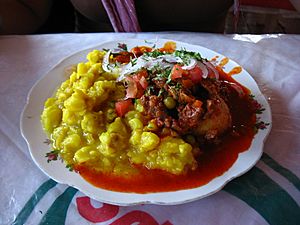Chuño facts for kids
 |
|
| Place of origin | Bolivia and Peru |
|---|---|
| Main ingredients | Potatoes |
Chuño is a special type of potato product. It's made by Quechua and Aymara communities. You can find it in countries like Bolivia and Peru. People in Chile and Argentina also know about it.
Chuño is made using a process called freeze-drying. This means potatoes are frozen and then dried. It takes about five days to make. Farmers put bitter, frost-resistant potatoes outside at night. The very cold temperatures in the Andean mountains freeze them. Then, the strong sunlight during the day dries them out. The word "chuño" comes from the Quechua language. It means 'frozen potato'.
Contents
History of Chuño
Chuño has a very long history! People were making it even before the Inca Empire started in the 1200s. Scientists have found chuño at old places like Tiwanaku. This was a big culture that lived in the Collao Plateau. This area includes parts of Bolivia and Peru.
A Spanish writer named José de Acosta described chuño in 1590. Inca soldiers ate chuño when they marched. It was easy to carry and lasted a long time. It also had good nutrition. Some people think that chuño production helped the Inca Empire grow. This is because the cold nights in the southern Peruvian highlands were perfect for making it.
How Chuño is Made
Chuño is made at the start of winter, usually in June and July. At this time, temperatures can drop to about -5°C (23°F). This happens in places higher than 3,800 meters (12,500 feet) above sea level.
After the potato harvest in April or May, farmers pick small potatoes. These are easier to process. They spread the potatoes close together on flat ground. The cold nights freeze them, and the daytime sun dries them. This natural freeze-drying takes about three nights.
Trampling the Potatoes
After freezing, the potatoes are moved to special flat areas. These places are called chuñochinapampas. This Aymara word means "the place where the chuño is made." Here, people walk on the potatoes. This helps to squeeze out any water left inside. It also removes the potato skins. This step helps the potatoes freeze and dry even more. They stay like this for over a week, depending on the weather.
Whole families often help with trampling the potatoes. The freezing process breaks down the potato cells. This makes it easier to remove the water. People build a small pile of potatoes with their feet. Then they "dance" on the pile. As they dance, the skins come off. Any remaining skin is removed by hand.
From this basic freeze-dry process, two main types of chuño are made:
White Chuño
White chuño is made by washing the frozen potatoes. In Bolivia, people spread the potatoes on blankets or straw. They spray them with water all the time. In Peru, the frozen potatoes are put into pools in a river. This washing usually takes about a week. The last step is drying them in the sun. The finished product is called chuño, or sometimes papas secas (which means "dry potatoes" in Spanish). In Bolivia, white chuño is also known as tunta.
Black Chuño
Black chuño is made directly from the freezing and trampling process. It is not washed or put in water again. After being frozen and trampled, it is simply dried in the sun. Making black chuño doesn't change much from region to region. Farmers are more likely to keep and eat black chuño themselves. White chuño is often sold more.
Storing and Eating Chuño
Once chuño is dried, it can last for a very long time. With good storage, it can last for decades!
People eat chuño in many different ways. It can be used in desserts or main dishes. Chuño flour is also an important ingredient in many dishes from Peruvian cuisine.
- Chairo is a very traditional soup from Bolivia. It is made with chuño, meat, and vegetables.
- In Bolivia, chuño is seen as different from a regular potato. You can't always use them in the same recipes. For example, Chairo soup isn't the same without ground chuño. Other ingredients can be changed, but not the chuño.
- Chuño is also traditional in southern parts of Peru, like the Arequipa and Puno regions.
- Another soup made with whole chuño is called jakonta.
- Chuño can also be eaten simply with different sauces.
Images for kids
See also
 In Spanish: Chuño para niños
In Spanish: Chuño para niños



